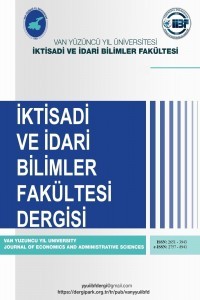TÜRKİYE’DE ENERJİ İTHALATI, CARİ AÇIK VE EKONOMİK BÜYÜME ARASINDA SİMETRİK VE ASİMETRİK NEDENSELLİK İLİŞKİLERİ
Enerji üretimin dolayısıyla da büyümenin en önemli girdilerinden biridir. Bununla birlikte, enerji kaynaklarına sahip olmayan ülkeler için de enerji aynı zamanda cari açığın en önemli nedenlerinden birisidir. Bu nedenle enerji ithalatı, cari açık ve ekonomik büyüme arasındaki ilişkilerin incelenmesi önemlidir. Bu çalışmanın amacı, Türkiye'de enerji ithalatı, cari açık ve ekonomik büyüme arasındaki ilişkileri simetrik ve asimetrik nedensellik analizleri kullanarak incelemektir. Bu kapsamda, 1974-2015 dönemine ait yıllık veriler kullanılmıştır. Elde edilen bulgulara göre, cari açık ile enerji ithalatı arasında karşılıklı nedensellik ilişkisi söz konusudur. Diğer taraftan enerji ithalatı ile ekonomi büyüme arasında simetrik analizde karşılıklı bir nedensellik ilişkisi söz konusudur. Asimetrik analizde ise sadece negatif bileşenlerde enerji ithalatı ekonomik büyümenin nedenidir.
Anahtar Kelimeler:
Enerji İthalatı, Cari Açık, Ekonomik Büyüme, Nedensellik Analizi
SYMMETRIC AND ASYMMETRIC CAUSAL RELATIONS BETWEEN ENERGY IMPORTS, CURRENT ACCOUNT DEFICIT AND ECONOMIC GROWTH IN TURKEY
It is one of the most important inputs of energy production and thus growth. However, energy is also one of the most important causes of current account deficit for countries that do not have energy resources. For this reason, it is important to examine the relationships between energy imports, current account deficit and economic growth. The aim of this study is to examine the relationships between energy imports, current account deficit and economic growth in Turkey using symmetric and asymmetric causality analyses. In this context, annual data for the period 1974-2015 were used. According to the findings, there is a bilateral causality relationship between the current account deficit and energy imports. On the other hand, there is a bilateral causality relationship between energy imports and economic growth in symmetric analysis. In the asymmetric analysis, only in negative components, energy imports are the cause of economic growth.
___
- Ayla, D., & Karış, Ç. (2019). Türkiye’de Enerji İthalatı ve Cari Açık Üzerine Bir Değerlendirme. Adıyaman Üniversitesi Sosyal Bilimler Enstitüsü Dergisi, sa 32, 380-412.
- Demir, M., (2013). Enerji İthalati Cari Açik İlişkisi, VAR Analizi ile Türkiye Üzerine Bir İnceleme. Akademik Araştırmalar ve Çalışmalar Dergisi (AKAD), cilt 5, sa 9, 2-27.
- Dickey, D. A., & Fuller, W. A., (1981). Likelihood Ratio Statistics for Autoregressive Time Series with a Unit Root. Econometrica: Journal of the Econometric Society, cilt 49, sa 4, 1057-1072.
- Ghosh, S., (2009). Import Demand of Crude Oil and Economic Growth: Evidence from India. Energy Policy, cilt 37, sa 2, 699-702.
- Granger, C. W., & Yoon, G., (2002). Hidden Cointegration. U of California, Economics Working Paper, 2002-02.
- Hacker, R. S., & Hatemi-J, A., (2006). Tests for Causality Between Integrated Variables Using Asymptotic and Bootstrap Distributions: Theory and Application. Applied Economics, cilt 38, sa 13, 1489-1500.
- Hatemi-j, A., (2003). A New Method to Choose Optimal Lag Order in Stable and Unstable VAR Models. Applied Economics Letters, cilt 10, sa 3, 135-137.
- Hatemi-j, A. (2012). Asymmetric Causality Tests with an Application. Empirical Economics, cilt 43, sa 1, 447-456.
- Hatemi‐J, A., & Irandoust, M., (2012). Asymmetric Interaction between Government Spending and Terms of Trade Volatility: New Evidence from Hidden Cointegration Technique. Journal of Economic Studies, cilt 39, sa 3, 368-378.
- Huntington, H. G., (2015). Crude Oil Trade and Current Account Deficits. Energy Economics, sa 50, 70-79.
- Phillips, P.C.B., & Perron, P., (1988). Testing for a Unit Root in Time Series Regression, Biometrika, sa 75, 335-346.
- Sarıtaş, H., Ayşe, G., & Tahsin, A., (2018). Türkiye’de Enerji İthalatı, Cari Açık ve Büyüme İlişkisi: VAR ve Granger Nedensellik Analizi. Ekonomik ve Sosyal Araştırmalar Dergisi, cilt 14, sa 2, 181-200.
- Şişeci, G. N., & Yamaçlı, D. S., (2020). Enerji İthalatı, Döviz Kuru ve Ekonomik Büyüme Arasındaki İlişki: Türkiye İçin Bir Araştırma. Sinop Üniversitesi Sosyal Bilimler Dergisi, cilt 4, sa 1, 253-276.
- Toda, H. Y., & Yamamoto, T., (1995). Statistical Inference in Vector Autoregressions with Possibly Integrated Processes. Journal of Econometrics, cilt 66, sa 1-2, 225-250.
- Uysal, D., Yılmaz, K., & Taner, T. A. Ş., (2015). Enerji İthalatı ve Cari Açık İlişkisi: Türkiye Örneği. Anemon Muş Alparslan Üniversitesi Sosyal Bilimler Dergisi, cilt 3, sa 1, 63-78.
- Üzümcü, A., & Başar, S., (2011). Türkiye’nin Cari İşlemler Bilançosu Açığı Üzerinde Enerji İthalatı ve İktisadi Büyümenin Etkisi: 2003–2010 Dönemi Üzerine Bir Analiz. Finans Politik ve Ekonomik Yorumlar Dergisi, cilt 48, sa 558, 5-22.
- Yurdakul, F., & Cevher, E., (2015). Determinants of Current Account Deficit in Turkey: The Conditional and Partial Granger Causality Approach. Procedia Economics and Finance, sa 26, 92-100.
- Ziramba, E., (2010). Price and Income Elasticities of Crude Oil Import Demand in South Africa: A Cointegration Analysis. Energy Policy, cilt 38, sa 12, 7844-7849.
- ISSN: 2651-3943
- Başlangıç: 2016
- Yayıncı: Van Yüzüncü Yıl Üniversitesi
Sayıdaki Diğer Makaleler
YENİLENEBİLİR ENERJİ VE GELİR DAĞILIMI İLİŞKİSİ: AB ÜLKELERİNDEN KANITLAR
Burhan HAKYEMEZ, Demet EROĞLU SEVİNÇ, Haktan SEVİNC
TÜRKİYE’YE YÖNELİK DOĞRUDAN YABANCI YATIRIMLARI ETKİLEYEN FİNANSAL FAKTÖRLER
BIST 30 VADELİ İŞLEM GETİRİSİ VE YATIRIMCI RİSK İŞTAHI: GRANGER NEDENSELLİK ANALİZİ
DÖVİZ KURLARI ARASINDAKİ GETİRİ VE VOLATİLİTE YAYILIMININ İNCELENMESİ: TÜRKİYE ÖRNEĞİ
Önder BÜBERKÖKÜ, Celal KIZILDERE, Gamze SEVİMLİ ÖRGÜN
DİJİTAL DÖNÜŞÜM, ENDÜSTRİ 4.0 VE KADIN İSTİHDAMI
Yener ALTUN, Ahmed Hassan ABDULLAH
Nazan GÜNGÖR KARYAĞDI, Nurettin KOCA
PHİLLİPS EĞRİSİNİN TÜRKİYE VE GELİŞMİŞ EKONOMİLER AÇISINDAN İNCELENMESİ
